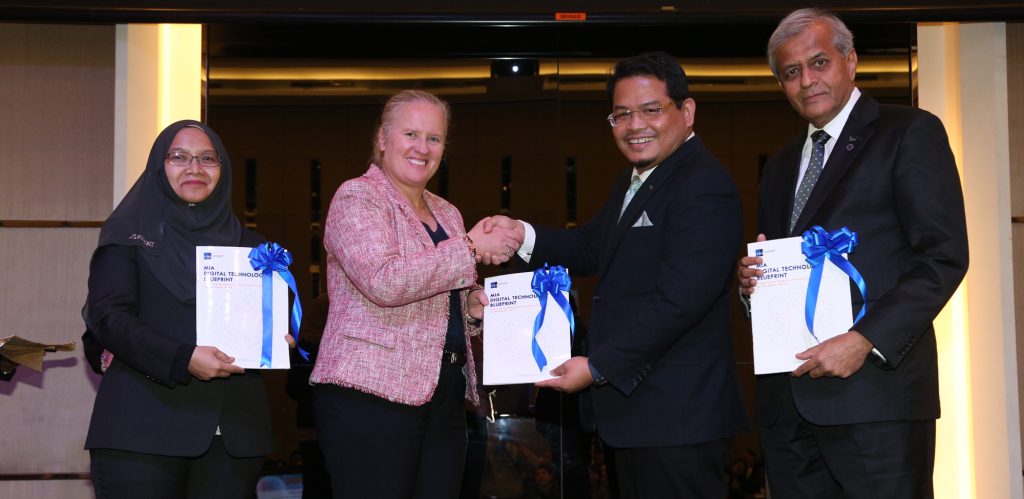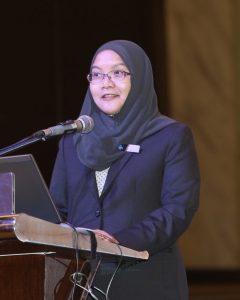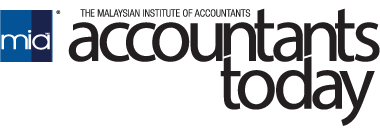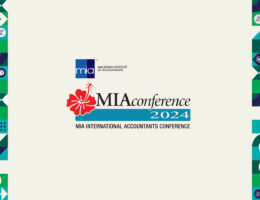
Preparing the Malaysian Accountancy Profession for the Digital Economy.
By Nazatul Izma
To help accountants manage sweeping changes arising from the digital economy and Industrial Revolution 4.0 (IR4.0), MIA launched its MIA Digital Technology Blueprint at its inaugural AccTech Conference 2018.
Although MIA observed rising interest in technology among its members ever since it held sessions on digital disruption at the MIA International Accountants Conference 2016 and 2017, it also noticed that accountants were uncomfortable with technology. ‘Accountants were asking which technologies relate to us and which ones do we take up first – artificial intelligence, blockchain, robotics or data? This motivated us to come up with this blueprint which is the culmination of two years’ worth of intense research and several roundtables with stakeholders,’ explained MIA CEO Dr. Nurmazilah Dato’ Mahzan. She noted that MIA also used numerous articles and resources from the International Federation of Accountants (IFAC) as guidance. ‘We closely followed the developments from IFAC and from there, we adapted it to our own document.’

The Blueprint begins by laying out the landscape of IR4.0 and how it impacts MIA members in four categories – commerce and industry (69%), public practice (23%), public sector (8%) and academia (2%). ‘We give an overview of the landscape and discuss Malaysia’s initiative in bringing the country to the next level of technology, because our accountants need to be at par and in tandem within this ecosystem and within the initiatives of our own government, like the Digital Free Trade Zone.’
Dr. Nurmazilah stressed that MIA is unable to provide individual solutions to members’ technological issues, because each and every member works within their own ecosystem and their companies and businesses have their own strategies. This document tries to overcome this by outlining five principles that MIA members need to think about:
- Assess digital technology trends. ‘First, be aware of what are the current technologies available out there. Get the information and learn more about these technologies.’ MIA’s role is to provide awareness of the trends and assess how they affect members.
- Identify capabilities. ‘Identify the person within your organisation who can champion these technologies. Who should be assigned to lead this?’ MIA will support members by providing training and the relevant certification for members to enhance their capabilities.
- Harness digital technologies. ‘Put a plan in place to start adopting and start using these technologies.’ MIA will help by promoting digital technology adoption and exploring collaboration with relevant stakeholders.
- Determine funding needs and identify funding options. ‘MIA did our own survey on technology adoption, which found that cost is a hindrance. If that is the case, why don’t you draw up a proper plan for funding? If your organisation is not able to buy the technology now, how about buying or adopting three years later? Start putting aside your budget for that. It has to be a conscious decision.’ On MIA’s part, it will engage with policymakers to enhance incentives and grants.
- Comply with good Governance practices including IT governance, as well as the relevant rules, laws and regulations. Here, MIA will help to develop and advocate good governance in digital technology usage and adoption.
From this starting point, formulate a checklist and carry out your own SWOT (strengths, weaknesses, opportunities and threats) analysis along these five principles, advocated Dr. Nurmazilah.
Support from IFAC
IFAC President Rachel Grimes, who delivered the keynote address and launched the Blueprint at AccTech 2018, commended MIA for initiating the Blueprint, which is not just an ASEAN first, but ‘also one of the first around the world that I’ve seen.’ She noted that ASEAN and broadly Asia are racing ahead of other regions by developing events and courses to make people aware of and embrace technology.
Rachel stressed the importance of good governance in facilitating technological transformation. She urged ‘technology steering committees to read the Blueprint because IT governance is rare and that is one of the key success factors. The inclusion of clear responsibilities and guidelines and steering committee members showing up are very important. They can’t delegate their responsibility. The best projects I’ve seen (for technological transformation) are when the members of the steering committee are all in attendance.’
Usually defined as a subset of corporate governance that is focused on information and technology, IT governance provides a structure for organisations to ensure that IT investments support business objectives. Finally, Rachel reminded those charged with governance to check whether the rules for IT governance are ‘still relevant and able to support tech adoption internally as part of our internal enterprise system.’
The Blueprint was prepared by the MIA technical team with inputs and guidance from MIA’s Digital Economy Task Force. The Blueprint can be downloaded from MIA’s website – https://www.mia.org.my/v2/downloads/resources/publications/2018/07/12/MIA_Technology_Blueprint_Spreads_format.pdf






